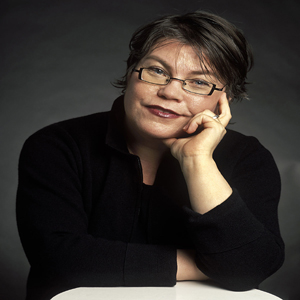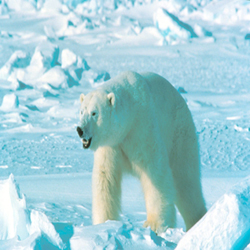 FEATURE FEATURE
|
|
Previous Article
People and Places/Alanna Mitchell
Mitchell follows the Darwin-trail.All the way to the Galapagos.
Source: Dancing at the Dead Sea, Date: , 2009
 Alanna Mitchell is a Canadian author and journalist who
writes about global science issues. She specializes in investigating changes to
the earth's life-support systems and travels the world in search of scientists
at the centre of what's going on. Alanna Mitchell is a Canadian author and journalist who
writes about global science issues. She specializes in investigating changes to
the earth's life-support systems and travels the world in search of scientists
at the centre of what's going on.
Her first book, Dancing at the Dead Sea: Tracking the
World's Environmental Hotspots, came out in 2004 in Canada and in 2005 in
the rest of the English-speaking world, to international praise. One hundred and fifty years after the
publication of On the Origin of Species, award-winning environmental
reporter Alanna Mitchell set out to retrace the idea of evolution and grapple
with the fact that a massive extinction of the planet's species was well under
way. So began a three-year odyssey in which Mitchell picked up where Darwin
left off, examining not just the origin but also the ultimate fate of our
world.
In this issue of Toxics Link we would bring before you one
of her adventures. That in the Sunken Graves of the High Arctic. “ For those who live high above the Arctic Circle,
survival depends on being able to read the code of snow and ice. And so they
watch.”  Thus began Alanna’s chronicle on Banks Island, a place
considered to be one of the most remote inhabited places in the north, the
westernmost island of the Arctic Archipelago. As a part of the world’s largest
polar desert, Banks Island cradles a barren plain covered in permafrost. But
global warming has affected the ecosystem of this remote land, too. Thus began Alanna’s chronicle on Banks Island, a place
considered to be one of the most remote inhabited places in the north, the
westernmost island of the Arctic Archipelago. As a part of the world’s largest
polar desert, Banks Island cradles a barren plain covered in permafrost. But
global warming has affected the ecosystem of this remote land, too.
Alanna finds that there is too much water. Unstable, and not
solid, Ice stretches to 6 or 7 kilometres and is dangerously thin and shifty.
Summers do not arrive. What arrives are windy days minus summer heat. Seals are
scarce and there is not enough to feed the dogs that pull the sleds. Ranges for
many plants and animals have shifted towards the poles. Plants are flowering
earlier, animals are breeding earlier. The ice covers on lakes and rivers in
the northern hemisphere is shortened by about two weeks. The polar bears are
also ill at ease. Baby polar bears live off seal pups who are born in the long
ice ridges. When it melts very fast the seal pups die and hence polar bear cubs
virtually starve to death. Adult polar bears are finding it tough to find
suitable ice cover for their hibernation. The musk ox now has a shorter life span. Often infected with
parasites who line the stomach and ulcerate it before seeping into the ox’s
blood stream, shorter winters in the Arctics mean longer life for these
parasites. This translates into shorter life for the musk ox as the presence of
the parasite in its system for longer-than-before time is pushing it to
untimely death. “Most people in the world never think about the Arctic, let
alone consider why it’s crucial to preserve this part of the world. Why does
the Arctic matter? Some try to argue it on social grounds: the Inuits and
Inuvialuit of North America are indigenous people… Others are nostalgic. They
don’t want this rich piece of earth’s human culture to vanish.  “Yet others see it through the lens of science: the Arctic
ice is the planet’s regulator of temperature and climate. Tiny changes to the
ice mean major changes to global climate. The snow and ice are like a hat on
the top of planet. They keep the heat in the sea and land so it doesn’t rise
into the atmosphere.” “Yet others see it through the lens of science: the Arctic
ice is the planet’s regulator of temperature and climate. Tiny changes to the
ice mean major changes to global climate. The snow and ice are like a hat on
the top of planet. They keep the heat in the sea and land so it doesn’t rise
into the atmosphere.”
But when snow and
ice melts…heat rises, which in turn melts more ice and snow. Thus “melting
feeds yet more melting.”
Due to greenhouse effect northern sea ice is 40 % thinner
than what it was 40 years ago and covers 14 % less area than it did 25 years
ago. Perma-ice is shrinking by 9 % a decade.
At the end of her visit she comes back home with lods of icy memories and "a massive piece of Arctic char, frozen solid ." Back home she cooks the fish for her two children . In her own words: " The three of us have never tasted anything so tender." Previous Article
|
|


 Alanna Mitchell is a Canadian author and journalist who
writes about global science issues. She specializes in investigating changes to
the earth's life-support systems and travels the world in search of scientists
at the centre of what's going on.
Alanna Mitchell is a Canadian author and journalist who
writes about global science issues. She specializes in investigating changes to
the earth's life-support systems and travels the world in search of scientists
at the centre of what's going on. Thus began Alanna’s chronicle on Banks Island, a place
considered to be one of the most remote inhabited places in the north, the
westernmost island of the Arctic Archipelago. As a part of the world’s largest
polar desert, Banks Island cradles a barren plain covered in permafrost. But
global warming has affected the ecosystem of this remote land, too.
Thus began Alanna’s chronicle on Banks Island, a place
considered to be one of the most remote inhabited places in the north, the
westernmost island of the Arctic Archipelago. As a part of the world’s largest
polar desert, Banks Island cradles a barren plain covered in permafrost. But
global warming has affected the ecosystem of this remote land, too. “Yet others see it through the lens of science: the Arctic
ice is the planet’s regulator of temperature and climate. Tiny changes to the
ice mean major changes to global climate. The snow and ice are like a hat on
the top of planet. They keep the heat in the sea and land so it doesn’t rise
into the atmosphere.”
“Yet others see it through the lens of science: the Arctic
ice is the planet’s regulator of temperature and climate. Tiny changes to the
ice mean major changes to global climate. The snow and ice are like a hat on
the top of planet. They keep the heat in the sea and land so it doesn’t rise
into the atmosphere.”